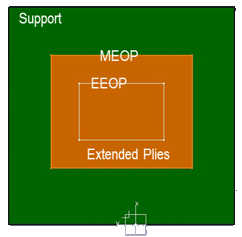Below is some information on creating a material excess with a staggering to create a
ramp.
The staggering is specified by
- The clearance. It is an offset from the MEOP, that defines the distance between the
smallest ply and the MEOP.
- The step. It is the distance between two plies to create the ramp.
- The drop-off pattern. It ensures the plies arrangement in a specific manner.
- The number of plies per drop. It is the number of plies on similar extended MEOP.
- The minimum clearance from the surface edge. It is the distance between the largest
ply and the support surface.
Each selected ply is extended to the corresponding extended MEOP.

One MEOP is created for each ply or set of plies. Each MEOP corresponds to one drop.
If you increase the number of plies per drop, some plies share the same drop, thus reducing
the number of created MEOP.
The number of created MEOP = Number of plies on a surface/Plies per drop.
Cases of Cutouts or Holes
- Plies, EEOP, and MEOP have adjacent cutouts. The plies and the EEOP share the same
outer and inner boundary.
- In this example, the plies and the EEOP share the same outer and the same inner
boundary.

- Result: Plies are staggered on the outer as well as on the inner boundary

- Plies and EEOP have cutouts, but there is no corresponding MEOP cutout. Plies and
the EEOP share the same outer and inner boundary.
- In this example, the plies and the EEOP have one outer and one inner boundary,
MEOP has only an outer boundary.

- Result: Plies are staggered on the outer boundary and there is no cutout inside
these plies.

- Plies have cutouts, but EEOP and MEOP do not. Plies and EEOP share the same outer
boundary, but the EEOP has no inner boundary.
- In this example, plies have one outer and one inner boundary. EEOP and MEOP have
only one outer boundary.

- Result: The plies are staggered on the outer boundary and there is a cutout
inside the plies. There is no staggering on the inner boundary.

- Plies and EEOP have no cutout, but MEOP has a cutout. Plies and the EEOP share the
same boundary.
- In this example, plies have one outer and one inner boundary. EEOP and MEOP have
only an outer boundary.

- Result: The plies are staggered on the outer boundary and there is a cutout
inside the plies. There is no staggering on the inner boundary.

Material Excess on Different Surfaces
If the selected plies are on different surfaces, the staggered plies are dropped on
respective surface, with respect to the corresponding MEOP.

Creation of Cut-Pieces
The creation of cut-pieces is the same as that of plies.



















